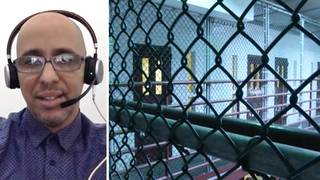
Guests
- Mark Maherstaff attorney for Reprieve US who has represented six men detained at Guantánamo Bay.
- Gary Thompsonattorney who has worked pro bono for Guantánamo Bay detainees.
Links
As the United States imposes new Cuba sanctions, citing human rights abuses, we look at the U.S. military prison in Guantánamo Bay, Cuba, a notorious gulag that President Biden himself has called an “advertisement for creating terror.” This month, the first Guantánamo Bay prisoner to be released under the Biden administration, Abdul Latif Nasser, returned to his home country of Morocco after nearly two decades of being held without charge even though he was cleared for release in 2016. There are 39 other prisoners still at Guantánamo, nearly two decades after the start of the U.S. war on terror. To discuss efforts to close the notorious prison and repatriate the remaining detainees, we are joined by Nasser’s lawyer Mark Maher of Reprieve and Gary Thompson, lawyer for former Guantánamo prisoner Ravil Mingazov, who is currently being held in a UAE prison after being released from Guantánamo in 2017, where he was held without charge for 15 years. “If there was ever a right and just time to be releasing these men, this is the time to do it,” says Maher.
Transcript
AMY GOODMAN: This is Democracy Now!, democracynow.org, The War and Peace Report. I’m Amy Goodman, with Juan González.
As the United States imposes new Cuba sanctions, citing human rights abuses, we turn to look at the U.S. military prison in Guantánamo Bay, Cuba. This month, the first Guantánamo prisoner to be released under the Biden administration returned to his home country of Morocco. Fifty-six-year-old Abdul Latif Nasser was imprisoned for nearly two decades without charge and was cleared for release by the U.S. military since 2016. Thirty-nine prisoners remain at Guantánamo.
This comes as activists gathered last week in front of the Cultural Attaché Office for the United Arab Emirates in Washington, D.C., to protest the planned rendition of former Guantánamo prisoner Ravil Mingazov back to Russia. He’s currently being held in a UAE prison after being released from Guantánamo in 2017, where he, too, was held without charge for 15 years. Advocates say 17 other former Guantánamo prisoners are now locked up in the UAE under inhumane conditions. This is Helen Schietinger of Witness Against Torture.
HELEN SCHIETINGER: They’ve been tortured. These men will live with that for the rest of their lives. We owe them reparations. We need to make sure that they are in good situations, and continue to follow them and support them in attempting to make the rest of their lives fulfilled.
AMY GOODMAN: For more, we’re joined by two lawyers representing these men. Gary Thompson is an attorney in private practice who has worked pro bono for Guantánamo prisoners. He is the lead attorney for former Guantánamo prisoner Ravil Mingazov. Also with us, Mark Maher, staff attorney for Reprieve US, who has represented six men imprisoned at Guantánamo, including Abdul Latif Nasser, who was just released to Morocco.
Mark, let’s begin with you. Can you tell us the circumstances under which he was just released? And what’s happening to Abdul Latif Nasser now?
MARK MAHER: Absolutely. Thank you for having me on.
So, the circumstances under which he was released actually begin back in 2016. As you said, Abdul Latif Nasser was held for close to two decades, 19 years, without charge or trial. He was actually cleared for release by the Periodic Review Board, which is a parole-like institution that was set up under Barack Obama’s presidency and is staffed by six members of federal agencies from the United States, including the Departments of Defense, Homeland Security and the Joint Chiefs of Staff. They determined, unanimously, that Abdul Latif Nasser posed no threat to the United States or anybody, and determined that he should be released from Guantánamo.
Unfortunately, this determination came quite late in Barack Obama’s presidency and the State Department at that time deferred to the next administration, which, as we all know, was the Trump administration. President Trump had campaigned on the idea of not closing Guantánamo and, in fact, not transferring anyone out of Guantánamo, and largely kept to that promise.
So, even though Abdul Latif Nasser was cleared by senior civil servants from the U.S. government, he had to sit and wait until the political will within the United States changed. And as thrilled as we are that Abdul Latif Nasser is now out, that he is back in Morocco and is with his family and is trying to start a new life and is focused on the future, the fact remains that he lost close to two decades of his life, and that a number of men, 27 men, are still there without charge or trial, waiting for the political will of this administration to change, as well.
JUAN GONZÁLEZ: And, Mark Maher, could you talk a little bit about how he came to end up in Guantánamo? How was he originally captured and transferred and detained there? And why did he never receive a trial?
MARK MAHER: Well, I can say that the reason why he never received a trial is the same reason why 27 of these men haven’t received a trial, either, and that’s because they have never faced any kind of charges at all. They’re being held essentially as prisoners of war.
Abdul Latif Nasser ended up in Guantánamo the way a lot of people ended up in Guantánamo. There was a bounty program, essentially, that was being run in Afghanistan and in Pakistan, I believe. The number, I might be getting wrong, but I believe what the bounties were being offered for turning over people to Afghan or American or Pakistani authorities was close to $5,000 at the time, which was a huge, life-changing amount of money. And we happen to know, in a lot of cases of people who ended up at Guantánamo, that they were the result of people lying about the people who ended up there, or simply mistaken identity.
That’s the case of another one of our clients who is still detained at Guantánamo Bay, Ahmed Rabbani. This story is actually detailed in the Senate torture report, that he was detained mistakenly because the United States believed he was another man, named Hassan Ghul. He was severely tortured, including techniques that haven’t been used since the Spanish Inquisition. The United States eventually actually detained Mr. Hassan Ghul at the same prison, Bagram, that Mr. Rabbani was being held at. Mr. Hassan Ghul was eventually released from there. But now, 20 years on, much like the situation that Abdul Latif Nasser found him in just a month ago, Ahmed Rabbani remains there. So, sadly, this is a situation that we’ve seen repeated for a number of the men who are still detained.
JUAN GONZÁLEZ: And the calls have been growing for the Biden administration to close Guantánamo. How could that be done? And do you think it’s likely?
MARK MAHER: Well, one of the easiest ways is to begin with releasing the 10 men who have been cleared for transfer, and working to release all 27 of the men, who have never been, again, charged with any crime or have faced a trial. It’s unlikely that any of those men will ever face any trial. This is especially true in light of the fact that, as I think your viewers and listeners will know, the Biden administration has announced that the War in Afghanistan is supposed to completely end by — I think mid-August was the last estimate that they had. And I believe earlier in the show, we heard President Biden saying that combat troops will be exiting Iraq by the end of the year. That says to me, and I think to a lot of observers, that the wars that led to these people being wrongly imprisoned in Guantánamo are ending.
If there was ever a right and just time to be releasing these men, this is the time to do it. The only thing that might be lacking from moving these men out of there is political will. If they haven’t been charged with anything, if they haven’t faced trial for anything, if the wars are over, then the question isn’t what can the Biden administration do to solve this problem; the question should be: What justification does the Biden administration still have to be detaining these people?
AMY GOODMAN: I want to bring Gary Thompson into the conversation, the attorney who worked pro bono for Guantánamo prisoners and is the lead attorney for Ravil Mingazov, who is a former Guantánamo prisoner. Can you tell us his full story and then where he’s ended up today, how he started at Guantánamo?
GARY THOMPSON: Yeah. Thank you very much.
Ravil Mingazov is from an area in Russia called Tatarstan. And he began to practice his chosen religion freely in the late 1990s. He was a professional ballet dancer, then drafted into the Russian army, and came to a point in his life where he decided he wanted to leave Russia and flee religious persecution simply to live a life of religious freedom with his wife and then-young baby. They attempted to travel south. Only Ravil made it across the border into Tajikistan, Afghanistan and then Pakistan, where he was arrested in March 2002 by Pakistani police and, as Mark Maher mentioned, also sold for bounty to United States authorities, who took him to Bagram, took him to Kandahar and tortured him. He suffered extreme interrogation and supposedly confessed under duress. He was then taken to Guantánamo in October of 2002, where he suffered greatly for many years under harsh conditions and sometimes solitary confinement.
Eventually, he was permitted to have counsel, which is where we came in. And we filed a petition for habeas corpus. And in 2010, here in D.C., where I live, Judge Henry Kennedy issued the writ of habeas corpus and ordered the United States government to release Ravil Mingazov from Guantánamo. Believe it or not, it then went through a — the case then went through a six-year Kafkaesque appellate cycle where he was not released. And then, in 2010, Ravil also went through a Periodic Review Board hearing, like Mr. Nasser, that Mark mentioned, and that same panel cleared Ravil for release.
It then took the State Department about six months to locate a country for Ravil to go to. He cannot go back to Russia, because Russia has a record of killing or torturing ex-Guantánamo detainees returned to them. So, we thought it was our lucky day when it was confirmed that Ravil could go to the United Arab Emirates, where several other or a dozen other ex-detainees also went. It was always Ravil’s dream to be in an Arab country. He learned Arabic in Guantánamo. He understood Arabic culture. He wanted to be there. And we really celebrated that day. Ravil was on the last plane out of Guantánamo the day before Donald Trump was inaugurated, so it really felt like we had dodged something terrible.
We were promised by our State Department that the UAE had promised them that Ravil would be released in six months, that he would be treated humanely, that he would be given a job and a place to live in about six months’ time, which is similar to the Saudi program for ex-Guantánamo detainees. It didn’t come to pass. It turned out that the UAE lied to the United States government. These so-called diplomatic assurances were simply all lies.
And Ravil, along with about two dozen other men, have suffered even more in UAE prisons, most notoriously the al-Razeen prison, these now four-and-a-half years. And they’re not permitted review by the International Red Cross or Red Crescent. They’ve been able to get out sporadic calls to their families with the help of Reprieve, where Mr. Maher works. The dots have been connected. We know there’s torture there. We know there’s mistreatment. And the men stuck in the UAE, like Ravil, have all said it’s worse than Guantánamo. Worse than Guantánamo. So, that’s why, with 18 men still there, we call the UAE “Gitmo East,” as opposed to “Gitmo West.” And with the numbers at Gitmo dwindling now to 39, with 18 in the UAE, they’re really a pair.
And if Biden is serious about closing Guantánamo, he needs to and his State Department needs to look into the concept of re-resettlement, look at people like Ravil Mingazov, some of the Chinese Uyghurs —
JUAN GONZÁLEZ: And, Gary Thompson —
GARY THOMPSON: [inaudible]
JUAN GONZÁLEZ: Gary Thompson, if I can, I just wanted to ask you about this particular issue of the UAE as Gitmo of the East. To your knowledge, what has been the U.S. government’s reaction to basically offloading its Gitmo prisoners to another gulag?
GARY THOMPSON: Totally complicit. The UAE — passed all these men off to the UAE and, as far as we know, did absolutely nothing to follow up on those diplomatic assurances. Apparently, our State Department, at least under Donald Trump, just didn’t care, didn’t care that they were lied to. And we’ve seen no evidence that our State Department, even now, under the Biden administration, is really doing anything to remedy the situation in the UAE. Some people in the State Department have told us they’re, you know, quote, “working on it” or they’re in touch with people in the UAE. But we’re seeing nothing. And in the meantime, we’re getting very, very scared that Ravil might be rendered to Russia or, in the case of the Yemenis who in the UAE, that their fate might take them back to Yemen, where they could suffer greatly.
AMY GOODMAN: I just wanted to remind people what Joe Biden said in the last Democratic presidential debate, when he was asked by PBS moderator Yamiche Alcindor about closing Guantánamo.
YAMICHE ALCINDOR: Vice President Biden, why couldn’t you close Guantánamo Bay? Why couldn’t the Obama administration close Guantánamo Bay?
JOE BIDEN: We attempted to close Guantánamo Bay, but you have to have congressional authority to do it. They’ve kept it open. And the fact is that we in fact think it’s the greatest — it is an advertisement for creating terror.
AMY GOODMAN: “It is an advertisement for creating terror,” the image of Guantánamo around the world, the fact of it. Mark Maher, your final words?
MARK MAHER: The only thing that — the only two things that I would add were to kind of hone in on something that Gary was saying there. He mentioned having petitioned for a writ of habeas corpus back in 2010. That would have been during Barack Obama’s presidency. And that means his Justice Department was opposing that petition for a writ of habeas corpus. We found ourself in a similar situation with our client, Asadullah Haroon Gul. His Justice Department, Mr. Biden’s, President Biden’s Justice Department took the same position that President Bush’s, President Obama’s, President Trump’s did, which is to attempt —
AMY GOODMAN: We have 10 seconds. What should Biden do?
MARK MAHER: — attempt — he should stop opposing these petitions for writ of habeas corpus and begin releasing all of the uncharged men who remain in Guantánamo Bay.
AMY GOODMAN: We want to thank Mark Maher and Gary Thompson, lawyers for at least two of the Guantánamo prisoners. I’m Amy Goodman, with Juan González. Stay safe.












Media Options